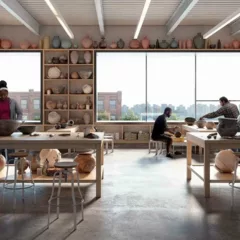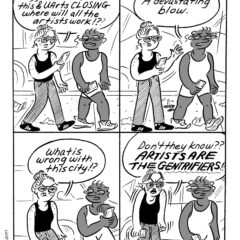This time of year, landscaping companies dominate the neighborhood – the ones with the gas-powered turbo-charged leaf blowers that ruin a quiet walk. One company in my neighborhood, which places its advertising yard sign on the grass of its customers like a “capture the flag” boast, is called “Great View,” to which I’ve always countered, “Where?” I guess a “great view” is in the eye of the marketing professionals.
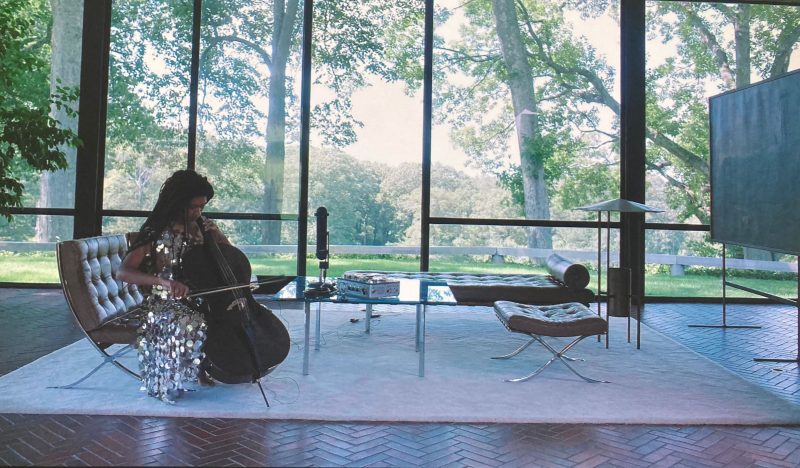
Landscape art is a longstanding tradition in the art world, and often landscape art is filled with great views. “New Typologies” at the Philadelphia Art Alliance presents work that shatters the longstanding tradition of “Luxe Calme et Volupté” and reminds us that the land has often been cruel and unstable as well as beautiful, an enemy and not a friend. Space is the new landscape – interior or exterior, suburban, urban, exurban, cyber, psychological, metaphysical, Afrofuturist, queer. Space is less a backdrop seen from afar than an immersion that is shaped by us and that shapes us – it is colored and alive and ever-changing.
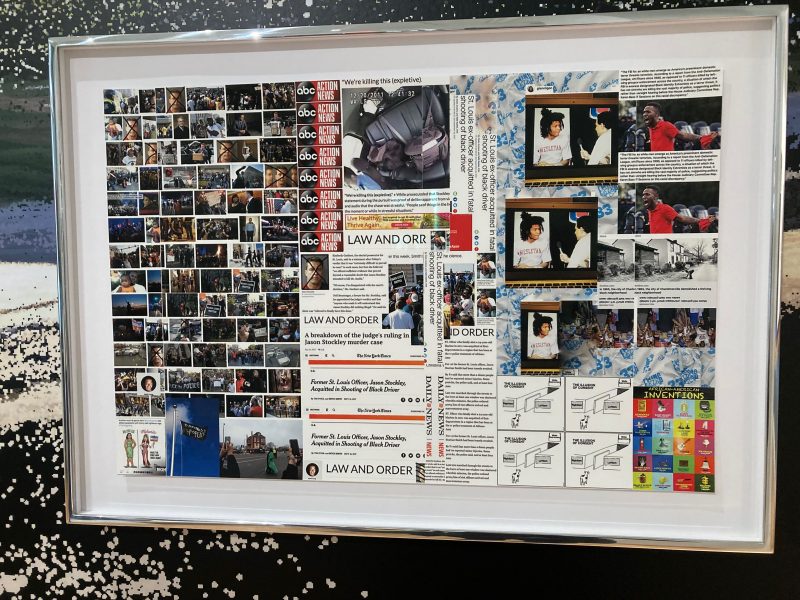
“New Typologies” brings together three different practitioners, David Hartt, Kahlil Robert Irving and James Hoff, whose pieces run the gamut from videos, to a jacquard weaving, to computer-glitch-made and manipulated prints. The ambiance throughout is not happy, and it’s not that far from a museum show of post-apocalyptic artifacts.
Khalil Robert Irving plies the internet to create word-image-obsessed collage pieces – and clay vessels that look like they come from a doomed civilization on another planet. If you look closely, you will see the artist’s image and name in his works. Filled with jittery energy, even while they are static and rooted in their repetitive use of words, the pieces define cyberspace as a jumble of carpal-tunnel-producing Google search results.
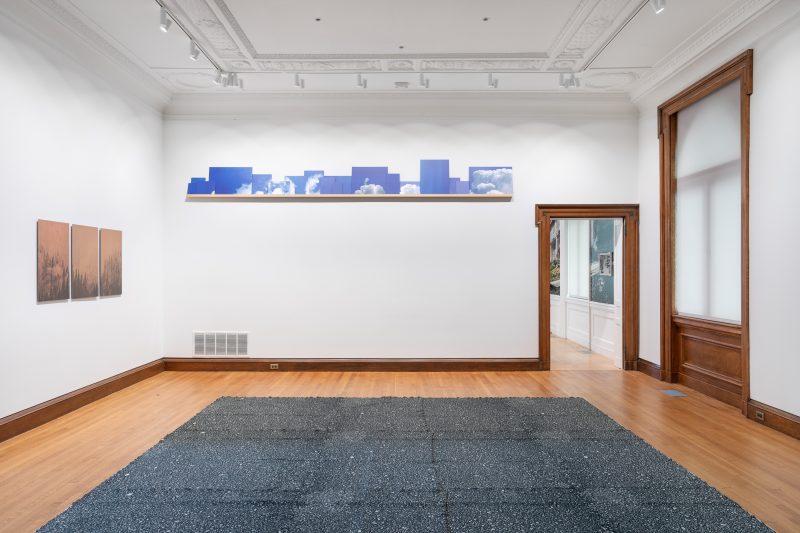
While the collage works are a solid critique of our worlds both real and online, Irving’s sculptural pieces are more nuanced and reverberant. “GROUND FOR MY FATHERS AND HIS FATHERS AND HIS FATHERS AND HIS FATHERS (SMOKE and Ashes),” is moving and elegiac. The minimalist sculptural piece on a low plinth is made of a number of black, jacquard-woven tapestries side-by-side that add up to a carpet-like mass. The texture is smooth, but white and gray bits intermixed give the piece a nubbly look. The piece is as celestial as the night sky, all Milky Way and eternal, but at the same time warm and touchable. Up close it takes on the appearance of the mundane – an asphalt “Every Street,” where children play during the day, and violence can happen at night under a starry sky. Confident in its imbalanced state of mundane and celestial, the piece sits nearby Irving’s “Sky_High *Low & fractured SMAERD),” which looks down from a high shelf, a photographic array of discontinuous images of puffy white clouds on slices of blue sky. Something about the perfect sky slices suggests both their commodification as products, as well as the untouchable, unknowable coldness of the universe. Irving was born in San Diego. Next year, he will have a solo exhibition at the Walker Art Center. More about the artist at his website.
Video is good at depicting space, given the “close up” and “birds eye view” options as well as the motion and sound which add up to an immersive experience. David Hartt’s two video projections are great–they are the sublime spectacles of this show. “On Exactitude in Science (Watts),” in the downstairs gallery, presents beautiful, poignant music and caressing camera sweeps of a depopulated interior and an exterior that looks like an undersea ruin. The siren song of music by Tomeka Reid lures you in and the images and music together insist on your presence telling you the tales of a Black neighborhood in Los Angeles, via reminiscences of one artist who lived/worked there, Charles Burnett.
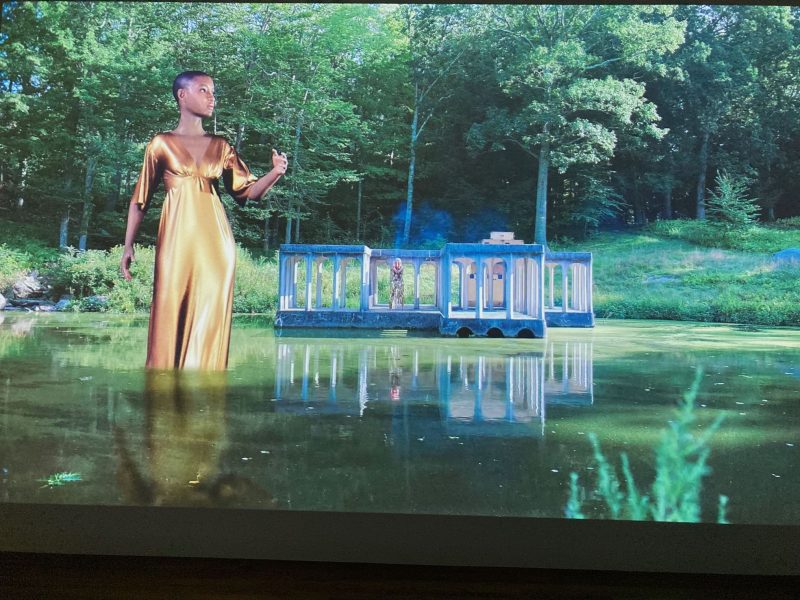
Hartt’s second video continues in the elegiac vein with music by Tomeka Reid, who also appears as Olimpia, playing a cello, composing at a desk and wandering the interior and exterior surrounds of the late architect Philip Johnson’s Glass House. Titled “Et in Arcadia Ego” the non-narrative work has another character in it, the beautiful Black giantess Orion, protector of Olimpia. In a piece that deals with transparency and color, the two Black characters seem to be claiming the architect’s space at the same time they are exorcising the folly of the Nazi-leaning modernist architect who rued his stupid and racist political views and admitted he could never atone for them. Classical references abound in the video, including the title–a reference to the Roman poet Virgil’s Arcadian stories, whose theme was that Death appears even in paradise. The phrase “Et in Arcadia Ego” was later used by Poussin as a title of his famous pastoral painting. David Hartt is a Canadian-born artist who now lives in Philadelphia and is associate professor in the Department of Fine Arts at the University of Pennsylvania. More about the artist here.
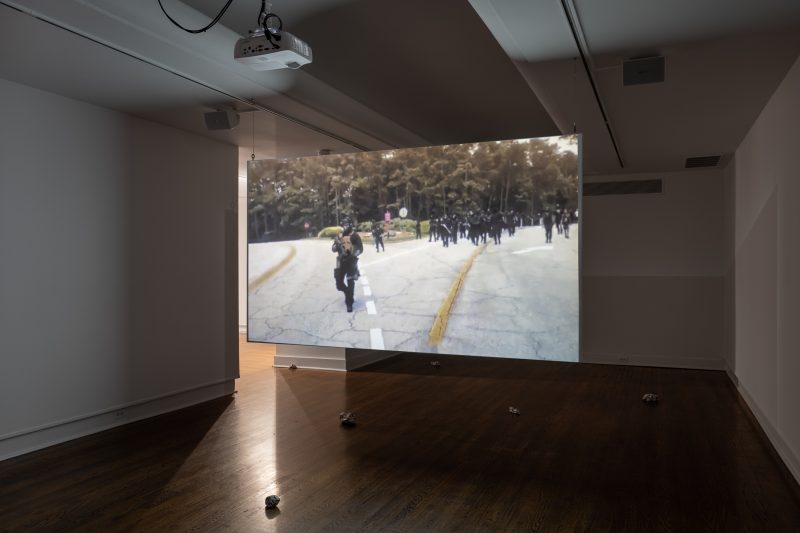
Wall-based works in the show by James Hoff are beautiful representations of trees and lands that are most likely endangered by climate change (or maybe destroyed by now). Works titled “Obsolete Landscape” or “Useless Landscape” portray regal evergreens and other trees and land based on images digitally manipulated through software and printed on copper plates. Technology and man triumphing over nature is the sad story of these works. Hoff’s video, made with DeForrest Brown, Jr., “HOBO UPF (v. The New World),” is a 19-minute video collage focused on the space where Black deaths happened at the hands of the police. Towards the end, a relentless stream of Google street views merged with police records of Black people who died is a dirge that is “felt weight” by many. James Hoff lives and works in Brooklyn where his practice encompasses multidisciplinary painting, sound, and performance which uses manipulated digital information to produce hybrid forms. More about the artist here.
New Typologies allows you the time (if you take it) to mull over issues of space. The three separate voices create a chorus in three-part harmony. Overall, the show conveys an urgency for its subject. The exhibit, which closes December 15, is best taken in slowly. It should definitely be taken in.
New Typologies, at the Philadelphia Art Alliance of University of the Arts closes Dec. 15, 2022.


